If you're new here, you may want to subscribe to my RSS feed. Thanks for visiting!
Author of Be Ready for Anything and Bloom Where You’re Planted online course
While visiting the Balkans, I’ve eaten some incredible food. To me, a huge part of travel is the cuisine of other areas as well as the types of food that are available in the stores.
Everything I’ve eaten in Bosnia and Croatia has been truly delicious, and their version of fast food is quite different than ours. I saw one Burger King on the way from the airport to Bosnia and everything else has been privately owned restaurants. The prices are excellent. A sit-down meal in a nice yet casual restaurant is about $10 US apiece in Bosnia and about $15 in Croatia. This includes 2 drinks, the main course, potatoes, bread, and some vegetables. Grabbing something at a small bakery is even less – in Bosnia, it costs maybe $1 US for a bag loaded with tasty baked goods.
There are some differences between the foods in Bosnia and Croatia, which I’ll get to in a moment.
But that isn’t the biggest difference
I feel so healthy and energetic here and I really think it’s the food. Everything you eat is local and freshly made. If there are fried potatoes served with your meal, you don’t see employees dumping frozen pre-cut potatoes into a deep-fryer. You see the person in the kitchen peeling and slicing potatoes.
The meat is from a butcher shop, not a factory farm. The produce is raised nearby. Nothing is frozen. GMOs aren’t a big thing over here, and neither is processed food. The food here is so much more “real” than what we’re served in many American restaurants, where the sauces are created at some plant then shipped to the restaurant where they are heated up and presented over food that was cooked from frozen.
As well, condiments aren’t a big thing here like they are in the US. Pizza is served with a drizzle of ketchup (ick – but you can get it without) as opposed to ranch dressing on the side. Salads in Bosnia are undressed and ones in Croatia are lightly dressed with local olive oil and vinegar. You can get ketchup for your fries of course. But whereas a lot of food in the US is drenched in sauces or gravies, here, the fine ingredients speak for themselves. At home, I’m a sauce and gravy person, but once I got used to it, I really liked the well-seasoned, sauceless food here.
Portion sizes here are not enormous but they’re generous. You leave the table full but not waddling away from it with an aching stomach. They don’t “supersize” here.
One restaurant I dined at in Croatia served this particularly wonderful chicken and potato dish. I talked to the hostess who told me nearly every ingredient at their establishment was raised at their nearby farm. They specifically farmed to fill their menu and brought in harvests on a daily basis. (The climate in the area where I spent most of my time was Mediterranean with a long growing season.)
The food in Bosnia
One of the first meals I had here was cevapi, which is a traditional Bosnian food.
Ćevapi are the national grilled specialty and one of the most famous Bosnian brands abroad. Ćevap is a small dumpling made of minced meat, mostly beef, with the addition of garlic, onion and different spices. The average length of one ćevap is about 5 cm.
Ćevapi are fried on the grill, and are traditionally served in somun or lepinja (type of homemade bread) dipped in grill sauce with the addition of finely chopped onions. (source)
The cevapi were delicious but the bread was out of this world. Which leads me to bread in general.
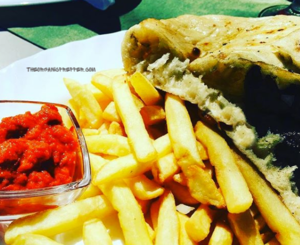
I think the lifeblood of Bosnia is bread. There, they are serious about bread. Every meal I’ve had has bread on the side and some meals are just bread. And, oh, is it good.
I’m not talking like sliced Wonder bread here, but concoctions that are only limited by your imagination. There are flaky pastries rolled around meat and then baked into a delicious spiral. There are breads filled with tangy cheese. There are breads glazed with salt. There are fluffy breads and shiny breads with a glorious egg wash. Wheat is a major crop in Bosnia which probably has something to do with the prevalence of bread.
In Bosnia, I picked up bread from a little bakery to savor over a couple of days. Every restaurant I visited served soft, delicious bread of some sort to enjoy with your meal.
Vegetables weren’t high on the menu in Bosnia – their salads were shredded lettuce and cabbage, topped with a slice of glorious, in-season tomato, and a slice of cucumber – no dressing. The tomatoes were awesome but aside from that, not tons of veggies were offered unless you ordered a vegetarian meal. The crux of each meal was meat, bread, and potatoes. No one is scared of carbs in Bosnia.
They grill lots of things in Bosnia – I had some incredibly delicious grilled chicken skewers, as well as grilled beef. If you are a meat and potatoes person, you’ll love Bosnian food.
The food in Croatia
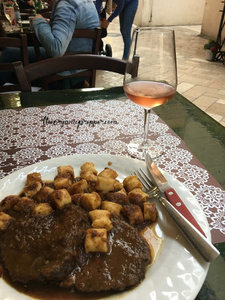
Moving on to Croatia, the Italian influence here is strong, but it has a Dalmation Coast twist. This area has been trading with Italy for more than a thousand years so you see a great deal of crossover in the cuisine. Other things that are very common here are olive products and seafood.
I personally dislike seafood, but the people with whom I’m traveling tell me that the seafood here is the best they’ve eaten. One extremely popular dish is “cuttlefish risotto” which is risotto cooked with cuttlefish, octopus, and other types of seafood and dyed black with squid ink. I tasted it, it was fishy, but my friend who ordered it classed it “divine.”
Restaurants here have a “meat menu” and a “fish menu.” Let me tell you about some of the things I’ve had.
First is this heavenly stew called pasticado, which is beef slow-cooked in a thick tomato and carrot base and served with gnocchi, which are little tasty potato dumplings. I had planned not to repeat any meals but this was so amazing I’ve had it twice.
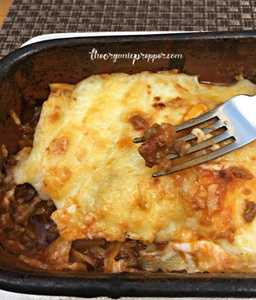
The pizza here is spiced a little differently than our pizza at home but it’s still delicious. My apartment in Croatia is right over a pizza shop so I’ve had that a couple of times too as quick fuel. It’s not as loaded with cheese as is ours in the US and the slices are enormous – like a quarter of a pizza. You fold it NYC-style to eat it. When you get your pizza they ask if you want spicy or regular ketchup and most people here get a drizzle on their slice. Personally, I haven’t been brave enough for ketchup on pizza.
I’ve had several pasta dishes, and all the pasta is made right there in the restaurant – you can see it hanging up to dry. Some highlights have been pasta similar to bow-tie pasta drenched in a creamy truffle sauce (drool) and lasagna, cooked and served in a small piece of crockery and layered with noodles, bolognese, and bechamel.
I had a piece of beef cooked in a mushroom sauce that wasn’t my favorite, but the potatoes on the side were crispy and wonderful. I also had a chicken breast stuffed with local cheese and bathed in olive oil. It was served with potatoes and red peppers.
The bread in Croatia isn’t anywhere nearly as good as the bread in Bosnia (sorry, Croatia!) but the pasta makes up for it. Also, we’ve had delicious local wine with nearly every meal here in Croatia.
Again, there are really no overweight people here.
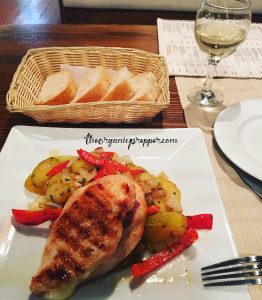
As I wrote in my previous article about the lifestyle here, you rarely see an overweight person here in the Balkans. And if you do, chances are they are tourists. I have lost so much weight I had to grab a belt for my pants that fit perfectly when I left home.
A lot of it, of course, is the high level of activity. I am staying in a third-floor walk-up in an area that is pedestrian only. There are miles and miles of cobbled streets here only open to foot traffic. But as someone mentioned in my article about the lifestyle here, you can’t chalk it all up to the activity level. It’s also closely related to the food.
They don’t really sell organic stuff here because they just grow things the old fashioned way – it’s all organic, or at least far more so than the conventional offerings in American grocery stores. The time I’m spending here has really illustrated to me how terribly unhealthy our American food supply really is.
And the things I’m eating would make most health-conscious folks cringe – pasta, potatoes, bread, meat, and an odd veggie. But it’s so fresh, wholesome, and nutritious that it’s having the opposite of the expected results.
The other amazing thing I’ve seen is that the people I’m with who have food intolerances at home are able to eat those foods here without issue. I avoid dairy because it causes skin problems for me, but here, I’ve eaten pizza and some foods with cheese or creamy sauces to no ill avail. A gluten-intolerant traveler I met up with said she had absolutely no issues with the local bread and pasta.
I am going to sincerely try to replicate this kind of food when I get home between my own garden and the farmer’s market and organic einkorn wheat for home-baked goods. We should all be asking what in the world is wrong with our tainted food supply in America.
Other articles in this series:
- Prepper’s Travel Diary: What I’m Packing
- Prepper’s Travel Diary: Traveling to Croatia
- Prepper’s Travel Diary: It’s a Different Lifestyle in the Balkans
- Prepper’s Travel Diary: Meeting Selco
- The Truth Modern Civil War in Photographs
About Daisy
Daisy Luther is a coffee-swigging, gun-toting blogger who writes about current events, preparedness, frugality, voluntaryism, and the pursuit of liberty on her website, The Organic Prepper. She is widely republished across alternative media and she curates all the most important news links on her aggregate site, PreppersDailyNews.com. Daisy is the best-selling author of 4 books and runs a small digital publishing company. She lives in the mountains of Virginia with her family. You can find her on Facebook, Pinterest, and Twitter.

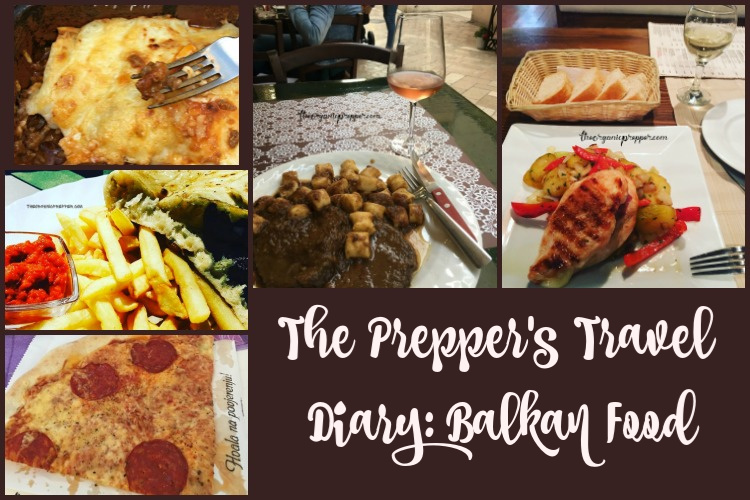














18 Responses
Wow, with all Daisy’s cooked from scratch meals at home, who would ever have though she was really a foodie! She may never come home!
we’re jealous! as previously noted, if you ever do a “prepper’s retreat for couples” my wife and I are all in.
I’m pretty sure they are going to do an open class soon which would be perfect for you and your wife. 🙂
DAUGHTER AND I HAVE SO MANY FOOD BOOBOOS I AM INTERESTED IN THE EFFECT THE FOODS THERE HAVE HAD ON YOUR GROUP
family have food sensitivities and food allergies most interested in effects of their food on your group
Oh, Daisy! I am so envious of your culinary adventures. However, unless I missed it, how’s the coffee? We fellow coffee conisuers need to know. 🙂
Very strong and very dark – I’m actually not a fan of it – just too strong for my liking.
Darn Daisy, you’re making me hungry.
I understand that prior to about 1940, all foods grown in the US were organic — meaning that the use of pesticides, herbicides, etc on cropland wasn’t introduced until about then. There is a long term trend that figures into this. In about 1880, roughly 80% of the US population lived on farms. By 1930 that percentage was down to about 30%. Today it’s somewhat under 2%. As giant sized operators moved in, the margins for small farmers shrunk them out of business. My own father had to move cattle onto his small farm in 1950 because the yields from wheat and maize (critical resources during WWII) simply couldn’t pay the bills any longer. Today, the two-mile stretch of dirt road I grew up on … has had all four houses bulldozed that once sheltered farm families.
So today to eat organic, you either buy locally, or pay through the nose for organic labeling (hoping you aren’t buying counterfeit, but without a good way to distinguish) at your grocer, or grow your own — if you have the time, energy and space, plus a civilized city government that’s not looking to break you with fines every time you turn around.
So here’s the big question: How did the Balkans manage to avoid this degradation of the food production business?
—-Lewis
My husband spent nearly a year working in Lithuania. He said everyone grew potatoes and they were much different than the ones in the States. Probably the soil. Also, there were kinds of tomatoes that we don’t grow here. And, he has never been a fan of bell peppers, but there he loved them.
He lived in the upper apartment of a family’s home and they had a garden. He would often come home from work and find his land lady had either cooked a meal for him, or left fresh veggies on his kitchen table. Potato dishes were his favorite.
A couple of my children like to put ketchup on their pizza and I told them that was weird! lol Maybe, deep down, we’re related to Croatians. =)
Thanks for sharing about the food. It’s fascinating to learn about other places. =)
Oh my goodness, your photos and descriptions of the cuisine got me drooling! Reminds me of Grandma’s cooking! And your observations are very interesting (and spot in IMHO), regarding the healthfulness of the food, verified by your traveling companions being able to eat things they can’t tolerated here in the US. Most of Europe (maybe all, I’m not sure) has banned GMO’s and things like Roundup.
I’ve heard some people who eat gluten-free say that when they travel out of the States, they are able to eat the bread without any ill effects. Something to do with how the flour is (over?) processed in America??
Dear Daisy,
I always read your blog,thank you for the interesting articles.
My wife and I have been holidaying in Croatia for 16 years and we love the place,we’ve traveled all over and it was where we rode horses through butterflies.It is important to see how other people live and we have made some incredably strong friendships with both Croat and Slovenian people .One thing you will have noticed is that you cannot stop Balkan people from giving,no, you just can’t stop them!
Travel broadens the mind and I suggest you try other European countries for more great experiences.
Britain has the widest and best range of cuisine ! But ,I would say that.!
Regards.
Your butterfly experience sounds wonderful, and I agree, Balkan people are incredibly generous!!!! I do look forward to traveling more now that my “baby” is grown up.
What’s wrong with our food supply? Monsanto, hormones, and round up.
In short, chemicals.
I love reading about your experiences in Croatia and Bosnia! Very interesting info on how people lose their food allergies and food problems when they are eating over there. I wonder how we lost the thread of simple, healthy food in this country?
I had some friends go to a retreat in Africa were everything was grown on location. They told me they did not eat differently than when in the states but they were losing weight in Africa. Our food is pretty adulterated with chemicals. I noticed have sensitivities to some cow dairy but one brand of organic cheese I get does not give me any trouble. The variety of wheat grown in the U.S is hybridized and from what I have read subjected to radiation to mutate it.